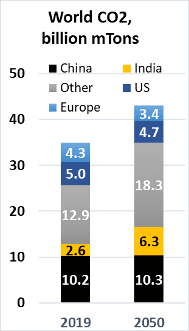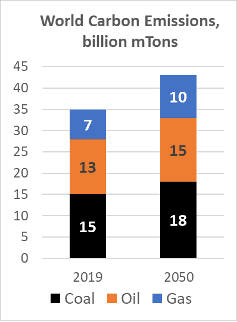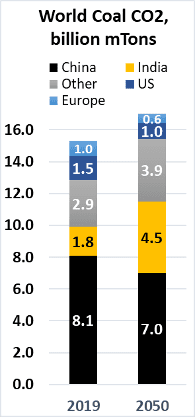Countries, states, cities, and businesses are committing to dramatic reductions in carbon to achieve NetZero emissions. Key drivers include 1) sustainable business goals – reduce costs, waste, and environmental impacts, and 2) government commitment and legislation to achieve net zero emissions by 2050.[1]
This article provides essential data analysis and a summary of recommended actions to increase investment and spur innovation that will help achieve Net Zero goals.

While both the E.U. and U.S. have reduced their respective carbon emissions by 20% from their peaks, this reduction was more than offset by increased emissions in the rest of the world, which grew from 23 to 35 billion tonnes between 2000 to 2019. Unfortunately, continued declines in the E.U. and U.S. will be nullified as total global emissions are projected to increase from 35 to 43 billion tonnes by 2050 (see Figure 1). [2]
To devise global strategies that rapidly reverse this direction, it is important to focus on significant emission sources. Figure 2 shows that coal and oil consumption contribute 80% of all worldwide carbon emissions.2 Table 1 below estimates the impact of the following strategies on achieving net zero by the year 2050.
- Strategy 1: Double current energy efficiency targets (all sectors).
- Strategy 2: Double renewable and carbon free power production targets.
- Strategy 3: Within in 10 years replace coal power plants with high efficiency natural gas power which emits <1,000 lbs./MWh. [3] Leveraging natural gas as a bridge strategy until non-hydro renewable (today only 8%) and carbon free power production scales.[4]
- Strategy 4: Replace 75% of autos with plug-in full electric (PEV) and plug-in hybrid (PEHV) vehicles. 1.2 billion vehicles in use today with a projected 2 billion vehicles by 2050.[5]
- Strategy 5: Fuel switching – Replace 60% of 1) coal fueled industrial processes (e.g., boilers, furnaces, dryers) with high efficiency natural gas and 2) 60% of residential & commercial fossil fueled devices with electric.
- Strategy 6: Carbon capture of 6 billion Tonnes through reforestation and sequestration.

To put the net zero challenge in perspective:
- Worldwide renewable power grew by 170 GW in 2018 compared to a target of 315 GW/yr. over the next 30 years, putting the world on a path to the renewable goal in Table 1.[6]
- Conversely, total auto plug-in electric (PEV and PEHV) sales of only 3 million/year worldwide compared to a target of 50 million/yr. for next 30 years.[7] Dramatic action is needed to rapidly push auto PEV sales to > 50 million/yr. About 90 million vehicles sold per year today.7
- Also, difficult to overcome is the projected increase in coal related carbon emissions from industrial and power use (see Figure 3). Dramatic action is needed if 2050 net zero goals are to be met. China and India produce 65% of worldwide CO2 from coal.2


We can expect national and state standards will be reinforced by consumers, local governments, and business actions. However, setting a standard or requirement in a monopoly market results in massive and inefficient deployment of capital, raising costs while minimizing outcomes. US freight, airlines, natural gas, telephone, and some state electric industries all shifted from monopoly to open markets, leading to investment, innovation, and cost/carbon reduction.
These key actions will rapidly reduce carbon emissions and put the world on a path to Net Zero by 2050:
- Consumers/Residential: 1) install solar PV on homes, 2) purchase PEV/PEH vehicles, 3) purchase renewable power, and 4) buy from companies with net zero carbon footprints.
- Buildings: Net Zero designs with LEED, building power meter aggregation, renewable power procurement, on-site renewable energy generation, grid harmonization, and distributed energy (storage, demand response).
- New Development: Implement Net Zero energy designs with meter aggregation, microgrids (e.g., solar, storage), and district energy. See city of Boston microgrid and district energy program as an example.[10]
- Industry: 1) Commit to and Initiate Environmental Sustainability Goal (ESG) requirements in the vendor supply chain, 2) shift auto and commercial fleet vehicle lines to PEV and PEHV vehicles as several major auto manufacturers have already committed to a full line of plug-in electric vehicles,[11],[12] 3) shift coal fired power and industrial boiler systems to renewable and high efficiency natural gas, and 4) embrace and invest in facility, campus, and city scale microgrids with local renewables (e.g. solar PV), storage, and completive procurement of grid supplied renewable power.
- Federal: 1) Set car and truck efficiency standards that can only be met with EV and PHEV, 2) Set a power production carbon standard minimum of 1,300 lbs./MWH4, 3) Implement carbon trading and renewable energy credit markets, and 4) Develop and promote carbon capture strategies and technology.
- States: 1) Implement renewable portfolio standards, 2) restructure electricity markets due to the resulting exponential investment in wind and solar power (e.g. US renewable increased from 2GW in 1998 to ~100GW),[13] 3) enable retail electricity competition, 4) implement community choice aggregation (CCA),[14] 5) enable microgrids with local renewables, 6) implement performance-based building efficiency standards with the US Green Building Council’s Leadership in Energy and Environmental Design (LEED), 7) incentivize implementation of distributed energy resources (e.g., solar PV, storage) in buildings with LEED grid harmonization strategies, and 8) implement fuel switching incentives and standards, and 9) promote and incentivize carbon sequestration and capture.
- Cities: Develop and implement 1) Net Zero plans including 2) community choice aggregation (CCA),15 3) strategies for microgrids with community solar, 4) building meter aggregation requirements, 5) electric vehicle programs, 6) higher density town centers connected by green ped-ways, and 7) sustainable transit.
- Utilities: Develop and implement 1) Net Zero distribution programs including investment in two-way power flow distribution systems that can accommodate >90% adoption of plug-in vehicles and solar PV. 2) This also includes joint city/utility Net Zero microgrid plans and utility incentives for or ownership of substation generation, charging stations, and solar PV.
[1] https://www.wearestillin.com/signatories, https://unfccc.int/news/commitments-to-net-zero-double-in-less-than-a-year, https://unfccc.int/climate-action/race-to-zero-campaign
[2] https://www.eia.gov/outlooks/ieo/pdf/ieo2019.pdf
[3] https://www.nwcouncil.org/sites/default/files/Final_CCCT-Presentation_101613.pdf
[4] https://www.c2es.org/content/renewable-energy/
[5] https://www.oica.net/, https://www.oica.net/category/sales-statistics/
[6] https://www.irena.org/newsroom/pressreleases/2019/Apr/Renewable-Energy-Now-Accounts-for-a-Third-of-Global-Power-Capacity
[7] http://www.ev-volumes.com/country/total-world-plug-in-vehicle-volumes/
[8] The U.S. IEO 2050 projected carbon emissions include a 210% increase in renewable generation which displaces roughly 9 billion tonnes
[9]This strategy is included due to the significant impact on local air quality.
[10]http://www.bostonplans.org/planning/planning-initiatives/boston-smart-utilities-project/
[11] https://group.volvocars.com/company/innovation/electrification
[12] https://www.reuters.com/article/us-autoshow-detroit-ford-motor/ford-plans-11-billion-investment-40-electrified-vehicles-by-2022-idUSKBN1F30YZ
[13] DOE EIA Annual Energy Outlook 2002 and 2019, https://catalog.data.gov/dataset/annual-energy-outlook
[14] https://www.leanenergyus.org/about
Learn more:
Click here to learn more about Wunderlich-Malec’s sustainability solutions.
